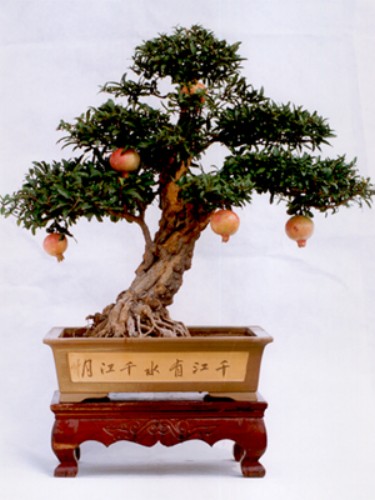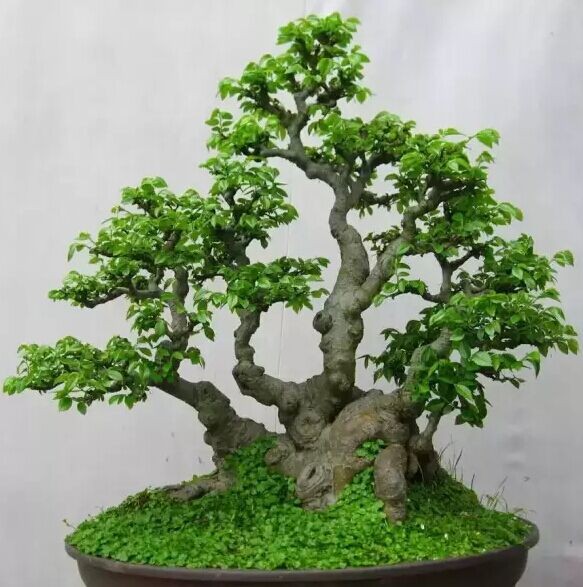The shape of pomegranate bonsai
Pomegranates like fertilizer, planting when the bottom of the pot to put a few pieces of animal hooves and a small amount of decomposed bean cake as base fertilizer. Pomegranates are adaptable and lax in soil requirements. They can grow in acidic or alkaline soil. The soil is loose and fertile, but they are afraid of waterlogging. For pomegranate potted plants, it is advisable to use medium-depth or darker purple sand pots or glazed pottery pots, and pay attention to coordinating the color of pots with the color of flowers. The shape of the pot depends on the shape of the pomegranate tree.

Bonsai according to its material selection and processing methods are different, mainly divided into tree stump bonsai and landscape bonsai two categories. For example, Zaozhuang Yicheng pomegranate bonsai is mainly composed of tree column bonsai, which takes pomegranate trees as the main body, sometimes also uses rocks and other materials as lining to make elegant and peculiar pomegranate bonsai, mainly to watch the various shapes of pomegranate trees and the characteristics of stems, flowers, fruits and branches and leaves. Through artistic processing and careful cultivation such as carving, tying, twisting, pruning, picking, bud wiping, peeling, cutting, bending, etc., the growth and development are controlled for a long time, resulting in a pomegranate bonsai that is close to the mountain forest and old and simple.
The main forms are as follows:
1, straight dry: the trunk is tall and straight, slim and graceful, branched at a height of 20-750px, chic and transparent.
2. Oblique dry type: the trunk tilts to one side, the branches and leaves are distributed naturally and orderly, and there is momentum in the balance of tree shape, which is more poetic than the upright shape of the trunk.
3, curved dry: the trunk is twisted, the tree is rich in change, but it cannot be bent too much, such as bending too many times, but it loses its beauty.
4. Lying dry: The main part of the trunk lies on the basin surface, like a tree struck by lightning. The tree shape is old and strange, full of wild interest.
5, cliff type: trunk Qiu Qu drooping, like downward growth of pine or radish vine.
6. Dry style: The trunk part is withered and the branches and leaves are still lush, such as dead trees in spring.
7, double dry: a tree double dry, should be a high and low, a bend and a tilt shape to show beauty.
8. Co-planting type: pomegranate trees with more than two trees, various varieties, flowering and fruiting, with different styles.
9. Attached stone type: pomegranate tree planted in stone crevice, rooted in basin soil, far looks like a long tree on a rock, simple and natural vivid into painting.
Time: 2019-06-13 Click:
- Prev

Plastic technique of pomegranate bonsai
At present, pomegranate bonsai is popular in the flower market. Judging from the market situation, the price of pomegranate bonsai with good shape is high but sells fast. Of course, good quality comes from good cultivation techniques. Today, the editor of the World Factory Modern Agriculture Network will send you a complete collection of pomegranate bonsai cultivation techniques. For thousands of years
- Next

Pruning of elm bonsai
Deciduous trees, up to 25 m tall and 1 m DBH, growing into shrubs in dry land; young trees with smooth, grayish brown or grayish bark, dark gray, irregularly deeply lobed, rough; branchlets glabrous or hairy, yellowish gray, brownish gray or gray, light brownish yellow or yellow, with scattered lenticels
Related
- Fuxing push coffee new agricultural production and marketing class: lack of small-scale processing plants
- Jujube rice field leisure farm deep ploughing Yilan for five years to create a space for organic food and play
- Nongyu Farm-A trial of organic papaya for brave women with advanced technology
- Four points for attention in the prevention and control of diseases and insect pests of edible fungi
- How to add nutrient solution to Edible Fungi
- Is there any good way to control edible fungus mites?
- Open Inoculation Technology of Edible Fungi
- Is there any clever way to use fertilizer for edible fungus in winter?
- What agents are used to kill the pathogens of edible fungi in the mushroom shed?
- Rapid drying of Edible Fungi

